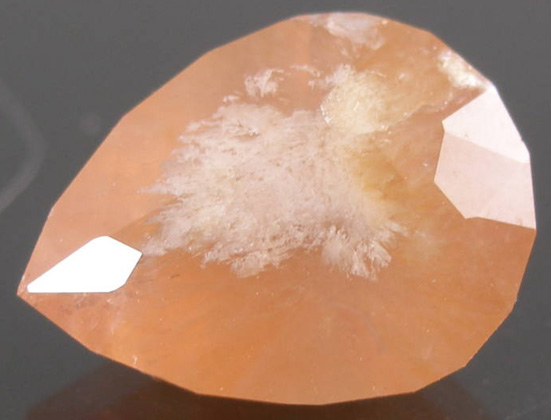Olmiite

Olmiite
(From South Africa. Weight: 4.2 carats)
Image © supplied by Woodmansee* Gems
Olmiite History & Etymology:
Olmiite is very rare and is also a recent discovery. It was first discovered in 2006 in the mines of N’Chwaning II in the Kalahari manganese fields of the Northern Cape Province in South Africa. Recent scientific research has shown that all the Poldervaartite mineral specimens are actually the Olmiite mineral. Since the two minerals cannot be distinguished by the naked eye, electron microprobe analysis is required. Hence Olmiite derive their name from Filipo Olmi for his work in the field of electron microprobe analysis at the CNR Instituto di Geoscienze e Georisorse sez di Firenze in Florence, Italy.
Olmiite Occurrence:
The Olmiite mineral is extremely rare and is hence found only in two localities across the world. Olmiite occurs in the mines of N’Chwaning II in the Kalahari manganese fields of the Northern Cape Province in South Africa as well as in the Wessels mines in the Kalahari manganese fields in Northern Cape Province.
Gemstones of Olmiite are extremely rare since faceting the gems is extremely difficult. The largest crystals of Olmiite have been found recently which are barely 5mm in size and weigh about 0.3 carats.
Olmiite Properties:
Olmiite is composed of varying percentages of calcium, manganese and silicon. The varying percentages of calcium and manganese are what differentiate Olmiite from the Poldervaartite mineral. Hence crystals which have more percentage of manganese are Olmiite crystals while crystals which have more calcium are Poldervaartite crystals.
This also means that most of the Poldervaartite minerals sold in the gemstone market are actually Olmiite crystals. Since it is difficult to visually distinguish the two crystals differentiation must be done using electron microprobe analysis.
The dominant silicon in the Olmiite crystals classifies the Olmiite as silicates mineral. The Olmiite crystals belong to the Olmiite-Poldervaartite Series. Olmiite display orthorhombic and dipyramidal properties and the Olmiite crystals exist as aggregates in their natural form. Olmiite also exist as prismatic crystals which are minimum 7 mm size. The aggregates of the Olmiite crystals sometimes exist in sheaves.
Olmiite does not display any cleavages but show uneven to irregular fracturing which causes the crystals to be extremely brittle. However the Moh’s hardness of the Olmiite crystals varies between 5 and 5.5. Olmiite are relatively dense at approximately 3 g/cm3. Olmiite also shows properties of luminescence with fluoresce of deep red under UV light of short wavelength. The Olmiite crystals are not radioactive.
Olmiite ranges in coloring from colorless to white and even orangish pink. Pure pink crystals of Olmiite rarely occur but are stunningly beautiful. Olmiite are usually transparent but inclusions cause some Olmiite crystals to appear translucent. Olmiite have a vitreous luster which changes to a glassy shine on the edges.
The refractive index of Olmiite is between 1.66 and 1.69 while the birefringence is at 0.03. The dispersion in the Olmiite crystals is quite distinct without any pleochroism. Olmiite generally occurs where hydrothermal alteration has taken place. Some rare gemstones of Olmiite which have a beautifully light peach pink color have been sold for hundreds of dollars per fraction of a carat.
Back to the Gemstones List home page - over 160 gemstones explored!
Please feel free to link to this page - copy / paste the text below: (click to select)
Privacy Policy | Cookie Policy | GDPR | About This Site / Terms

© gemstoneslist.com 2018


